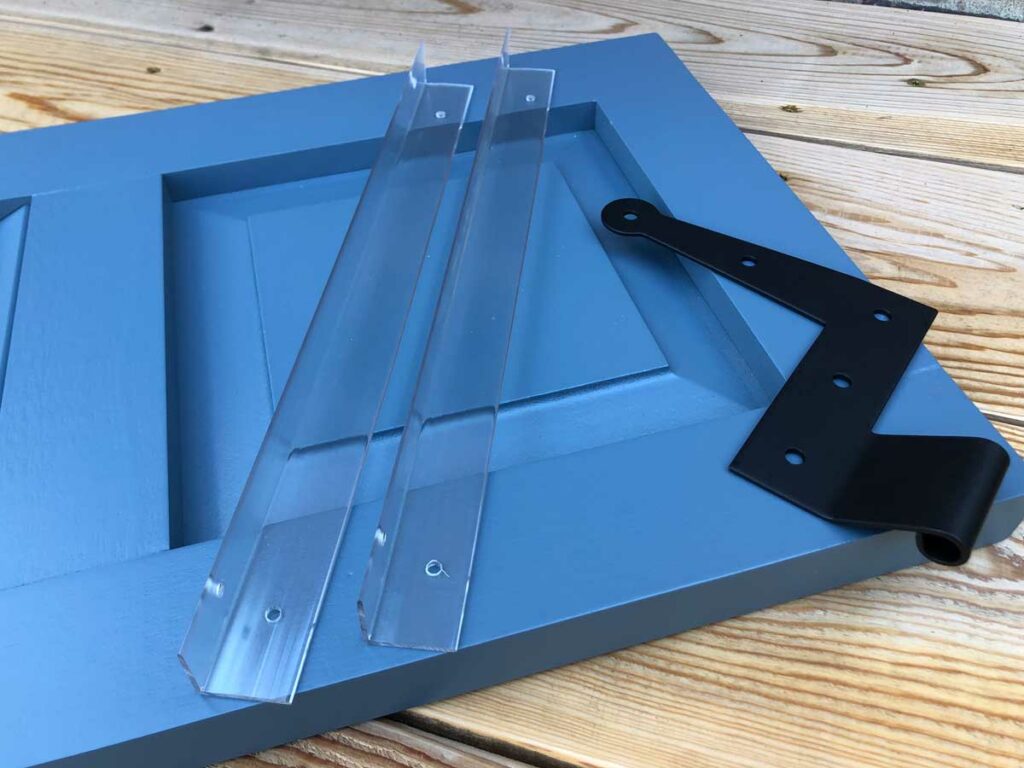How to Install PVC Exterior Shutters
PVC exterior shutters are extremely versatile and can be installed with fixed mounting brackets or with operable hardware. The determination of what method to be used should be made in the measuring stage. The proper size of functional shutters is more imperative because they need to fit together over the window opening. Measurements of fixed PVC outdoor shutters are less critical and there is a little margin to approximate the rough area. Stationary mounting brackets are available for every PVC shutter ordered.

Follow the steps outlined below for a successful installation of exterior PVC shutters. Use the videos in conjunction to the written instruction. This guide is applicable to PVC louvered, solid panel, combination or board and batten shutters.
Install Exterior Shutters to Operate
Step 1: Briefly hold the shutters in the window opening with shims to establish equal spacing top and bottom with adequate margins both sides and middle. The bottom rail of the panels is equal to or larger than the top and the louvers will slant down and away from the window. Approximately 1/8 to 1/4 inch is necessary to install exterior shutters to swing freely. Outside shutters may be trimmed slightly (less than 1/4”) to increase clearance if necessary. Prime and paint the cut edge to continue.
Step 2: Observe and remove any obstructions that may prevent the panels from swinging fully open.
Step 3: With the shutters still in the window, identify where the exterior hanging hinges will attach. Use the hinge schedule below to determine how many hinges are required to support the weight of PVC shutters. Use pieces of painter’s tape to mark each hinge location on the shutter, which can be extremely valuable when installing multiple window shutters at one time.
Attach Shutter Hinges
Step 4: Remove the panels and place horizontally on sawhorses or another flat elevated surface. The side of the outdoor shutter that was facing out will now be facing up. Replace the painter’s tape in one corner with the selected hinge. Align the strap or New York Style L-hinges vertically to the edge of the panel and horizontally to the center of the rail. Mortise hinges and narrower surface mount hinges often align more centrally.
PVC Shutter Hinge Schedule
| Shutter Height | “Strap” or “Acme” hinges |
|---|---|
| If < 84” | 3+ hinges: top, bottom & center 1 lower support (shutter dog or wall bracket) |
| If > 84” | 4+ hinges: top, bottom & center 1 lower support (shutter dog or wall bracket) |

Install Shutter Dogs
Step 7: Place the panels to the window for the last time, extended wide to the side of the opening. Identify the best shutter dog mounting point. Shutter dogs keep the panels anchored against the house and rotate to release the panels to swing freely. The lag bolt entry point should be about 1/4 the width of the shutter from the outside edge. The lower edge of the shutter needs to rest on the lag bolt for support.
Step 8: Predrill a hole to accommodate the dog bolt. Ratchet the bolt so the back of the shutter dog meets the panel face in when fully open.
Step 9: Secure the remaining external hardware to complete the installation.
Install Exterior Shutters to be Stationary
Lexan mounting brackets are available to install PVC shutters in a fixed position. The polycarbonate supports are clear and will not distract from an attractive presentation. Holes in Lexan brackets are not pre-drilled. Use a 1/4″ bit to drill two holes on one edge of the first bracket. The holes should be about 2″ from each end of the bracket. Then drill holes on the other edge of the bracket, each about 2.5″ from the bracket end (this makes sure the screws do not intersect). Repeat this process for all of the long brackets. Some shutters require additional support with centered side bracket(s). Drill one hole on each edge of the smaller brackets (offset to avoid intersecting screws).
Installation Tools Necessary
Most installations require:
- Sturdy ladder
- Cordless drill
- 1/8 inch drill bit
- Ratchet wrench set
- Stainless steel screws and corresponding driver bit
- 1/4 inch spacers
- Level
- Wood filler
- Putty knife
- Touch-up paint
Additional provisions may be necessary. Every window on every house is unique, which results in a unique approach and application for each situation.
PVC tropical Bahama shutters are installed with a top mounted hinge. Separate instructions are provided to install Bahama shutters.

